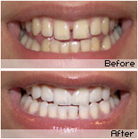Cosmetic - Tooth Bonding
What is Tooth Bonding?
 Bonding can fix crooked, gapped or badly stained teeth.
Bonding can fix crooked, gapped or badly stained teeth.
Tooth bonding is a cosmetic dental procedure that bonds tooth-colored material (resin) to the surface of a tooth. Bonding is likely the easiest and least expensive of cosmetic dental procedures.
The resin used in bonding can be shaped and polished to match the surrounding teeth. Bonding can also be used to create temporary veneers to see if you like the new look before you decide to undertake a more involved procedure, such as porcelain veneers.
Bonding is used to:
- Reshape teeth
- Fix crooked teeth
- Close unwanted gaps
- Cover (and whiten) badly stained teeth
Unlike veneers, bonding can be done in a single visit. The procedure is called bonding because the material bonds to the tooth.
No preparation is needed for bonding and anesthesia is usually not necessary. The resin used in bonding can be shaped and polished to match the surrounding teeth. Sometimes, bonding can also be used as a cosmetic alternative to amalgam fillings or to protect part of a tooth's root that has been exposed due to gums receding.
To do a bonding procedure, Dr. Sun will use a shade guide to select the composite resin color that will match the color of the tooth. Once he has chosen the color, he will slightly etch the surface of the tooth to roughen it. The tooth will be coated lightly with a conditioning liquid, which helps the bonding material adhere. When the tooth is prepared, he will apply the resin and then mold and smooth it until it's the correct shape.
The resin is then hardened with an ultraviolet light or laser. After the bonding material hardens, Dr. Patel will further shape it. He will then polish the resin until it matches the look of the rest of the tooth's surface. It usually takes less than an hour to complete the bonding procedure for one tooth.
The bonding resin is not as strong and durable as a natural tooth and can sometimes be chipped. Bonding can last several years before it needs repair.
